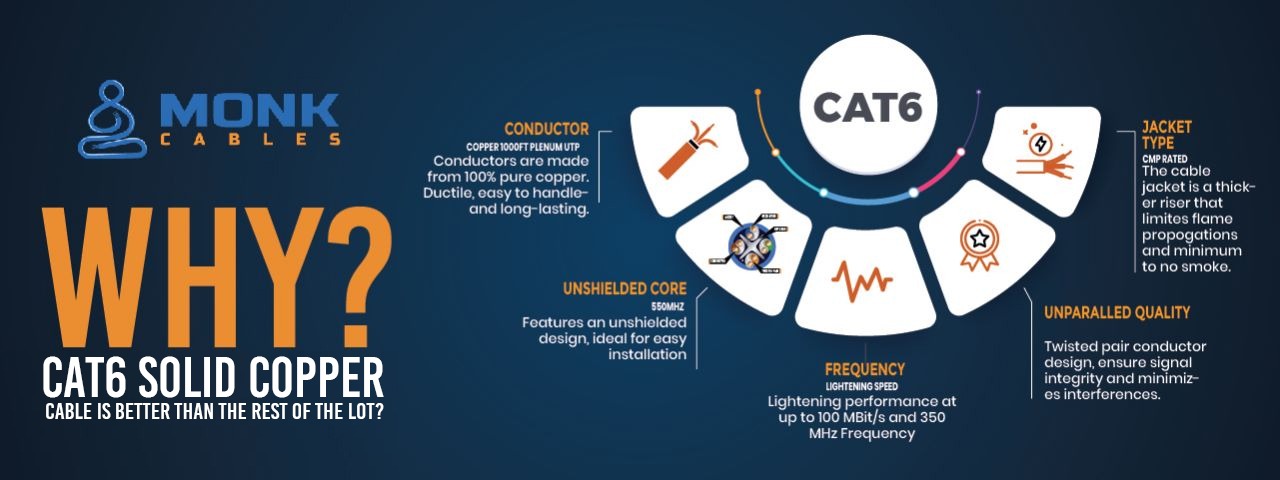
Category 6 cable is the sixth generation of Ethernet cables. This Ethernet cable standard has been defined by the TIA & EIA. Cat6 solid copper Ethernet cable is gradually replacing its predecessor cat5 and cat5e. This cable has backward compatibility. For instance, you can use this cable with older categories and it will work perfectly fine. There are many useful features that you will get with this cable. For instance, you will certain enjoy the excellent conductivity of this cable. It means you will not have to deal with signal loss. The connection stability is a must especially if you have giant networks.
In this article, we’ll talk about category 6 solid copper cable and what makes it better than the rest. So, let’s start.
Category 6 cables have the capabilities to support gigabit Ethernet applications. You can also use these cables for 10Gigabit Ethernet connection but for shorter distance. There are Rj45 connectors on the both termination of the cable. These are standard connectors for almost every Ethernet cable.
The category of a cable is printed on its outer jacket so that you can know about that cable. There are four copper wires inside the cable. These wires are twisted together to reduce crosstalk and electromagnetic interference. If there is an extra layer of protection around those twisted pair then that cable would be shielded cat6. If there is not any layer around these pairs then this cable would be unshielded twisted pair cable.
You can use shielded twisted pair cable for longer distances and it will not affect the integrity of your data package. In addition to that, shielded cat6 is a bit expensive.
Cat6 Ethernet cables come as a major improvement over their predecessor. These cables have better protection, faster data transfer rate, and enhanced connectivity. You can use cat6 Ethernet cable for gigabit Ethernet applications at a lower rate.
The internal structure of these both categories are the same. There are four copper wires that are twisted together to create four pair. These pair avoid any crosstalk and electromagnetic interference. The major difference between these two categories is the data transfer rate. You will get 1Gbps data transfer rate with cat6.
Many people choose cat5e over cat6. But you should keep in mind that you will have to replace them sooner or later if you want to get 10 Gigabit Ethernet and high-speed connectivity.
There are usually three types of outer jacket of cat6 solid cable; plenum, riser, and PVC. You should get one that sits well with your surroundings. It all depends on your deployment structure. For example, if you are planning an outdoor deployment, you should always go for a PVC cable. Since this cable has a premium-quality plastic jacket, it can withstand extreme heat and cold weather condition. Furthermore, rain and sunlight will not bother this cable.
Plenum cat6 – plenum spaces are those that have regular airflow for air conditioning and heating in a building. These horizontal spaces become dangerous in an event of a fire. A plenum cable would burn slowly with less toxic fumes keeping your property safe. You should always install plenum cables in plenum spaces.
Riser ca6 – these are vertical spaces of your building like an elevator shaft. You can install plenum-rated cables in these spaces but not the other way around.
PVC cat6 – polyvinyl chloride or PVC is ideal for outdoor conditions. These cables can withstand extreme temperatures and harsh weather conditions.
Cat6 solid copper Ethernet cables are ideal for both home and enterprise-level networks. You can use them for high-speed and reliable connectivity. In addition to that, this cable can technically support a 10Gbps data transfer rate at 55 meters. Moreover, this cable has generally more than 2 twists per centimeter. This gives it a better chance to fight off crosstalk and EMI. Crosstalk is a phenomenon that happens when signals from two passing by cables interact with each other. This can affect the data integrity of your cable. You do not want that especially if you are running these cables for an enterprise-level network.
You only want the best for your networking needs and this cable has got you covered. Whether it’s speed, signal strength, or conductivity, cat6 solid copper is the best option for your networking needs.